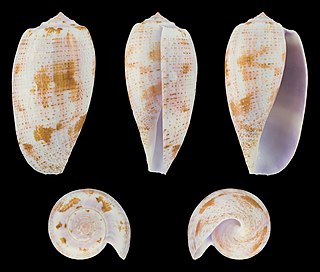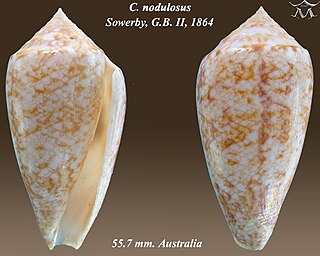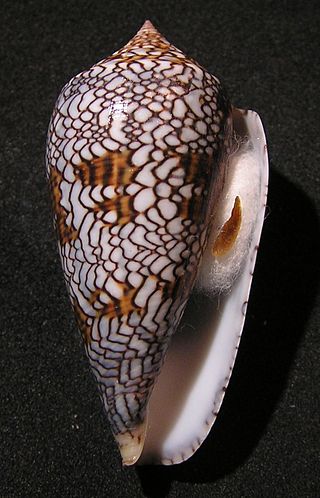
Cone snails, or cones, are highly venomous sea snails of the family Conidae.

Conus textile, the textile cone or the cloth of gold cone is a venomous species of sea snail, a marine gastropod mollusk in the family Conidae, the cone snails, cone shells or cones. Textile cone snails live mostly in the Indian Ocean, along the eastern coast of Africa and around Australia.

Conus geographus, popularly called the geography cone or the geographer cone, is a species of predatory cone snail. It lives in reefs of the tropical Indo-Pacific, and hunts small fish. While all cone snails hunt and kill prey using venom, the venom of conus geographus is potent enough to kill humans.

Conus artoptus, common name the tender cone, is a species of sea snail, a marine gastropod mollusk in the family Conidae, the cone snails and their allies.

Conus attenuatus, common name the thin cone, is a species of sea snail, a marine gastropod mollusk in the family Conidae, the cone snails and their allies.

Conus consors, common name the singed cone, is a species of sea snail, a marine gastropod mollusk in the family Conidae, the cone snails and their allies.

Conus ermineus, common name the turtle cone, is a species of sea snail, a marine gastropod mollusk in the family Conidae, the cone snails and their allies.

Conus floccatus, common name the snowflake cone, is a species of sea snail, a marine gastropod mollusk in the family Conidae, the cone snails and their allies.

Conus fulmen, common name the thunderbolt cone, is a species of sea snail, a marine gastropod mollusk in the family Conidae, the cone snails and their allies.

Conus legatus, common name the ambassador cone, is a species of sea snail, a marine gastropod mollusk in the family Conidae, the cone snails and their allies.

Conus regius, common name the "crown cone", is a species of sea snail, a marine gastropod mollusk in the family Conidae, the cone snails and their allies.

Conus striatus, common name the striated cone, is a species of sea snail, a marine gastropod mollusk in the family Conidae, the cone snails and their allies.

Conus terebra is a species of sea snail, a marine gastropod mollusk in the family Conidae, the cone snails and their allies.

Conus tulipa, common name the tulip cone, is a species of sea snail, a marine gastropod mollusk in the family Conidae, the cone snails and their allies.

Conus magus, common name the magical cone, is a species of sea snail, a marine gastropod mollusk in the family Conidae, the cone snails and their allies.

Conus nodulosus is a species of sea snail, a marine gastropod mollusk in the family Conidae, the cone snails and their allies.

Cylinder is a subgenus of sea snails, marine gastropod mollusks in the genus Conus, in the family Conidae, the cone snails and their allies.

Floraconus is a subgenus of sea snails, marine gastropod mollusks in the genus Conus, family Conidae, the cone snails and their allies.

Conus vidua, common name the vidua cone, is a species of sea snail, a marine gastropod mollusk in the family Conidae, the cone snails, cone shells or cones.
CNF-Sr3, also known as conorfamide-Sr3, is a toxin derived from the venom duct of Conus spurius. CNF-Sr3 is an inhibitor of the Shaker channel, a subtype of the voltage-gated potassium channels.
























